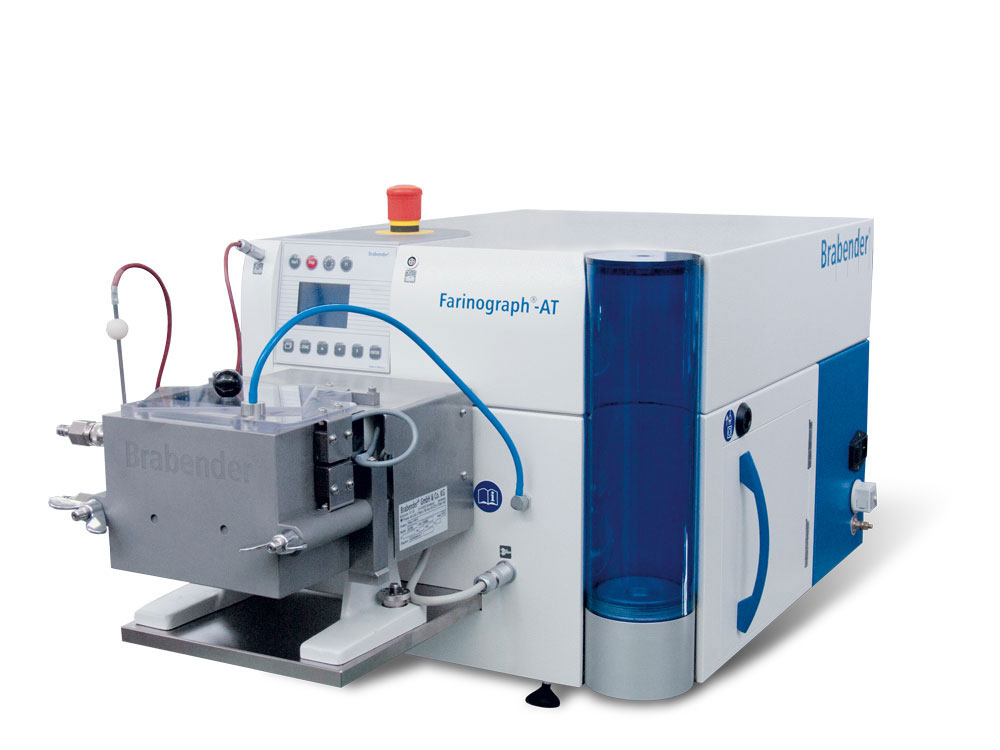|
Farinograph
In baking, a farinograph measures specific properties of flour. It was first developed and launched in 1928. The farinograph is a tool used for measuring the shear (fluid), shear and viscosity of a mixture of dough, flour and water. The primary units of the farinograph are Brabender Units, an arbitrary unit of measuring the viscosity of a fluid. A baker can formulate end products by using the farinograph's results to determine the following: *Water absorption *Dough viscosity, including peak water to gluten ratio prior to gluten breakdown *Peak mixing time to arrive at desired water/gluten ratio *The stability of flour under mixing *The tolerance of a flour's gluten Method The farinograph is drawn on a curved graph with the vertical axis labeled in Brabender Units (BU) and the horizontal axis labeled as time in minutes. The graph is generally hockey-stick shaped, with the curve being more or less acute depending on the strength of the gluten in the flour. The points of interest ... [...More Info...] [...Related Items...] OR: [Wikipedia] [Google] [Baidu] [Amazon] |
Farinograph2
In baking, a farinograph measures specific properties of flour. It was first developed and launched in 1928. The farinograph is a tool used for measuring the shear and viscosity of a mixture of flour and water. The primary units of the farinograph are Brabender Units, an arbitrary unit of measuring the viscosity of a fluid. A baker can formulate end products by using the farinograph's results to determine the following: *Water absorption *Dough viscosity, including peak water to gluten ratio prior to gluten breakdown *Peak mixing time to arrive at desired water/gluten ratio *The stability of flour under mixing *The tolerance of a flour's gluten Method The farinograph is drawn on a curved graph with the vertical axis labeled in Brabender Units (BU) and the horizontal axis labeled as time in minutes. The graph is generally hockey-stick shaped, with the curve being more or less acute depending on the strength of the gluten in the flour. The points of interest on the graph are fi ... [...More Info...] [...Related Items...] OR: [Wikipedia] [Google] [Baidu] [Amazon] |
Gluten
Gluten is a structural protein naturally found in certain Cereal, cereal grains. The term ''gluten'' usually refers to the elastic network of a wheat grain's proteins, gliadin and glutenin primarily, that forms readily with the addition of water and often kneading in the case of bread dough. The types of grains that contain gluten include all species of wheat (common wheat, durum, spelt, Khorasan wheat, khorasan, emmer, and Einkorn wheat, einkorn), and barley, rye, and some cultivars of oat; moreover, cross hybrids of any of these cereal grains also contain gluten, e.g. triticale. Gluten makes up 75–85% of the total protein in Common wheat, bread wheat. Glutens, especially Triticeae glutens, have unique viscoelasticity, viscoelastic and Adhesion, adhesive properties, which give dough its elasticity, helping it Proofing (baking technique), rise and keep its shape and often leaving the final product with a chewy texture. These properties, and its relatively low cost, make gluten v ... [...More Info...] [...Related Items...] OR: [Wikipedia] [Google] [Baidu] [Amazon] |
Flour
Flour is a powder made by Mill (grinding), grinding raw grains, List of root vegetables, roots, beans, Nut (fruit), nuts, or seeds. Flours are used to make many different foods. Cereal flour, particularly wheat flour, is the main ingredient of bread, which is a staple food for many cultures. Maize flour, Corn flour has been important in Mesoamerican cuisine since ancient times and remains a staple in the Americas. Rye flour is a constituent of bread in both Central Europe and Northern Europe. Cereal flour consists either of the endosperm, cereal germ, germ, and bran together (whole-grain flour) or of the endosperm alone (refined flour). ''Meal'' is either differentiable from flour as having slightly coarser particle size (degree of comminution) or is synonymous with flour; the word is used both ways. The Centers for Disease Control and Prevention, CDC has cautioned not to eat raw flour doughs or batters. Raw flour can contain harmful bacteria such as ''E. coli'' and needs ... [...More Info...] [...Related Items...] OR: [Wikipedia] [Google] [Baidu] [Amazon] |
Baking
Baking is a method of preparing food that uses dry heat, typically in an oven, but it can also be done in hot ashes, or on hot Baking stone, stones. Bread is the most commonly baked item, but many other types of food can also be baked. Heat is gradually transferred from the surface of cakes, cookies, and pieces of bread to their center, typically conducted at elevated temperatures surpassing 300 °F. Dry heat cooking imparts a distinctive richness to foods through the processes of caramelization and surface browning. As heat travels through, it transforms batters and doughs into baked goods and more with a firm dry crust and a softer center.p.38 Baking can be combined with grilling to produce a hybrid barbecue variant by using both methods simultaneously, or one after the other. Baking is related to barbecuing because the concept of the masonry oven is similar to that of a smoking (cooking), smoke pit. Baking has traditionally been performed at home for day-to-day meals an ... [...More Info...] [...Related Items...] OR: [Wikipedia] [Google] [Baidu] [Amazon] |
Shear (fluid)
Shear stress (often denoted by , Greek alphabet, Greek: tau) is the component of stress (physics), stress coplanar with a material cross section. It arises from the shear force, the component of force vector parallel to the material cross section. ''Normal stress'', on the other hand, arises from the force vector component perpendicular to the material cross section on which it acts. General shear stress The formula to calculate average shear stress or force per unit area is: \tau = ,where is the force applied and is the cross-sectional area. The area involved corresponds to the material face (geometry), face parallel to the applied force vector, i.e., with surface normal vector perpendicular to the force. Other forms Wall shear stress Wall shear stress expresses the retarding force (per unit area) from a wall in the layers of a fluid flowing next to the wall. It is defined as:\tau_w := \mu\left.\frac\_,where is the dynamic viscosity, is the flow velocity, and is the ... [...More Info...] [...Related Items...] OR: [Wikipedia] [Google] [Baidu] [Amazon] |
Viscosity
Viscosity is a measure of a fluid's rate-dependent drag (physics), resistance to a change in shape or to movement of its neighboring portions relative to one another. For liquids, it corresponds to the informal concept of ''thickness''; for example, syrup has a higher viscosity than water. Viscosity is defined scientifically as a force multiplied by a time divided by an area. Thus its SI units are newton-seconds per metre squared, or pascal-seconds. Viscosity quantifies the internal friction, frictional force between adjacent layers of fluid that are in relative motion. For instance, when a viscous fluid is forced through a tube, it flows more quickly near the tube's center line than near its walls. Experiments show that some stress (physics), stress (such as a pressure difference between the two ends of the tube) is needed to sustain the flow. This is because a force is required to overcome the friction between the layers of the fluid which are in relative motion. For a tube ... [...More Info...] [...Related Items...] OR: [Wikipedia] [Google] [Baidu] [Amazon] |
Dough
Dough is a malleable, sometimes elastic paste made from flour (which itself is made from grains or from leguminous or chestnut crops). Dough is typically made by mixing flour with a small amount of water or other liquid and sometimes includes yeast or other leavening agents, as well as ingredients such as fats or flavourings. Making and shaping dough begins the preparation of a wide variety of foodstuffs, particularly breads and bread-based items, but also including biscuits, cakes, cookies, dumplings, flatbreads, noodles, pasta, pastry, pizza, piecrusts, and similar items. Dough can be made from a wide variety of flour, commonly wheat and rye but also maize, rice, legumes, almonds, and other cereals or crops. Types of dough Doughs vary widely and may be ''enriched'' with eggs, sugars, spices, and fats. With respect to enrichment, the dough are forming a spectrum with two extremes: * lean dough contains mostly the basic ingredients (flour, water, salt, and, ... [...More Info...] [...Related Items...] OR: [Wikipedia] [Google] [Baidu] [Amazon] |
Arbitrary Unit
In science and technology, an arbitrary unit (abbreviated arb. unit, '' see below'') or procedure defined unit (p.d.u.) is a relative unit of measurement to show the ratio of amount of substance, intensity, or other quantities, to a predetermined reference measurement. The reference measurement is typically defined by the local laboratories or dependent on individual measurement apparatus. It is therefore impossible to compare "1 arb. unit" by one measurer and "1000 arb. unit" by another measurer without detailed prior knowledge on how the respective "arbitrary units" were defined; thus, the unit is sometimes called an unknown unit. The unit only serves to compare multiple measurements performed in similar environment, since the ratio between the measurement and the reference is a consistent and dimensionless quantity independent of what actual units are used. Units of such kind are commonly used in fields such as physiology to indicate substance concentration, and spectroscop ... [...More Info...] [...Related Items...] OR: [Wikipedia] [Google] [Baidu] [Amazon] |
Bread
Bread is a baked food product made from water, flour, and often yeast. It is a staple food across the world, particularly in Europe and the Middle East. Throughout recorded history and around the world, it has been an important part of many cultures' diets. It is one of the oldest human-made foods, having been of significance since the dawn of Agriculture#History, agriculture, and plays an essential role in both religious rituals and secular culture. Bread may be Leavening agent, leavened by naturally occurring microbes (e.g. sourdough), chemicals (e.g. baking soda), industrially produced Baker's yeast, yeast, or high-pressure aeration, which creates the gas bubbles that fluff up bread. Bread may also be Unleavened bread, unleavened. In many countries, mass-produced bread often contains Food additive, additives to improve flavor, texture, color, shelf life, nutrition, and ease of production. Etymology The Old English language, Old English word for bread was ( in Gothic langua ... [...More Info...] [...Related Items...] OR: [Wikipedia] [Google] [Baidu] [Amazon] |
Rule Of Thumb
In English language, English, the phrase ''rule of thumb'' refers to an approximate method for doing something, based on practical experience rather than theory. This usage of the phrase can be traced back to the 17th century and has been associated with various Trade (occupation), trades where quantities were measured by comparison to the width or length of a thumb. An erroneous folk etymology began circulating in the 1970s falsely connecting the origins of the phrase "rule of thumb" to legal doctrine on Domestic violence, domestic abuse. The error appeared in a number of law journals, and the United States Commission on Civil Rights published a report on domestic abuse titled "Under the Rule of Thumb" in 1982. Some efforts were made to discourage the phrase, which was seen as taboo owing to this false origin. During the 1990s, several authors correctly identified the spurious folk etymology; however, the connection to domestic violence was still being cited in some legal sources ... [...More Info...] [...Related Items...] OR: [Wikipedia] [Google] [Baidu] [Amazon] |







